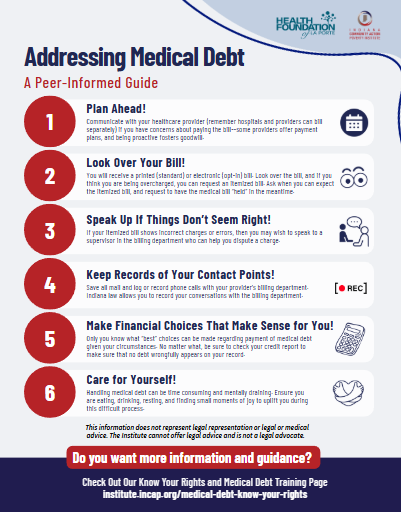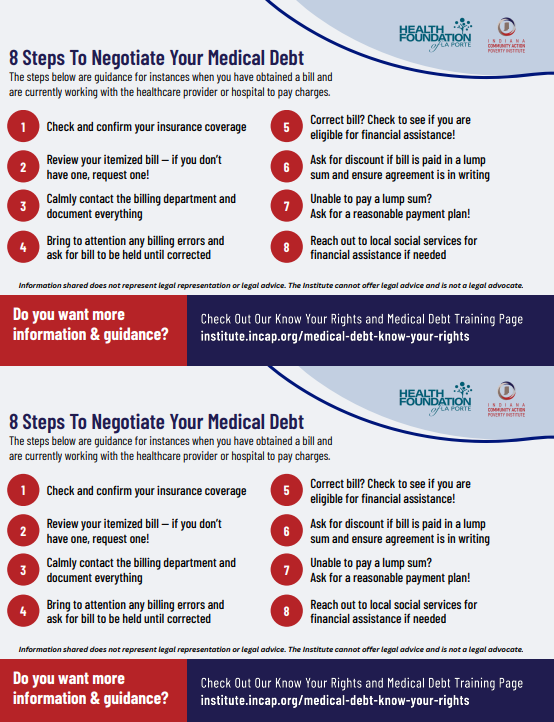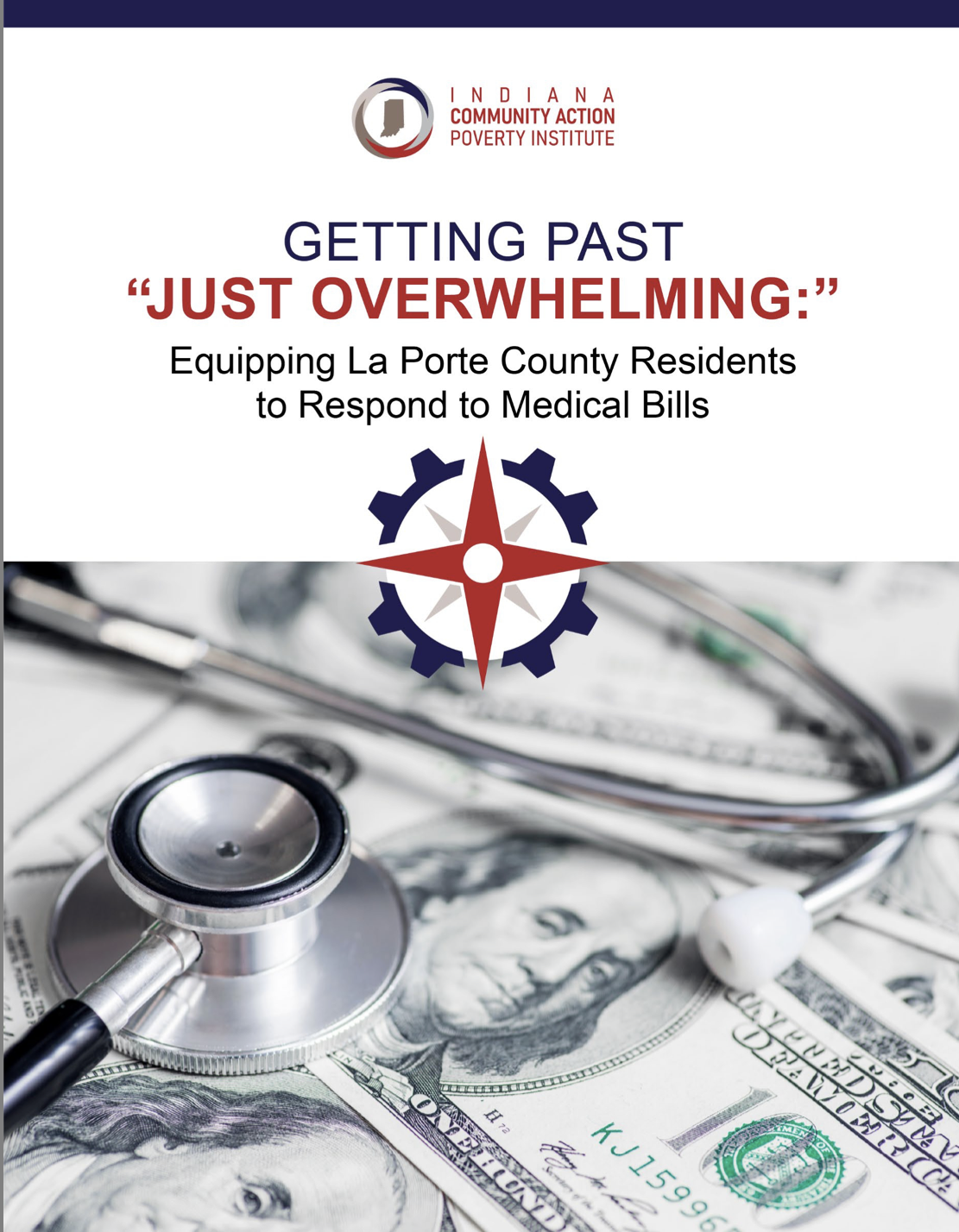- Institute Home
- Research
- Reports
- TANF
- Medical Debt
- The Link Between Employment and Well-Being
- Billed to the Breaking Point
- Live a Day (Workforce to Disability)
- Financial Drain (Payday Lending)
- Overlooked and Undercounted
- The Status of Working Families
- Clearing the Jobs Pathway (Adult Learners)
- Wages, Wealth and Poverty
- Paid Family & Medical Leave
- Policy Briefs
- Fact Sheets
- Presentations
- Community Needs Assessments
- Listening to Hoosiers
- Reports
- Policy Advocacy
- Blog
- Take Action
- Who We Are
- Media
- Donate
- INCAA Home
Medica Debt Navigation SupportsThrough a partnership with Health Foundation of La Porte, the Institute created a number of free materials to support individuals navigating medical debt. We have downloadable and printable infographics, as well as plaint-text versions of the information. All information shared on this page does not represent legal representation or legal advice. The Institute cannot offer legal advice and is not a legal advocate. Jump to Downloads | Continue to Plain-Text Content (Tri-Fold Pamphlet; Large Infographic; Small Infographic) Know Your Rights Training VideoBefore and after the video, please fill out our pre- and post-training survey forms to help us know how we did and the ways in which we can do better!
Dealing with Medical Debt: A Peer-Informed Guide3 Quick Tips to Help You Address Medical Debt: 1. Ask for financial assistance 2. Ask for an itemized bill 3. Negotiate and ask for a discount on cost 3 Tips and Tricks to Reduce Medical Bills: 1. Disputing a bill: If you receive a medical bill that feels way more expensive than you were expecting, you can dispute it. This means you call the hospital billing department, tell them the bill was higher than expected, and ask for an itemized bill sent to your home. You can request also to not make payments until after you have received the itemized bill. This is called holding a bill, and this can give you time to confirm that the charges are correct (they do not have to hold your bill). Once you have the itemized bill, you can check the charges and then call the billing department if you found an error. NOTE: It is common for hospitals and providers to bill separately! Be sure to request itemized copies of BOTH bills. 2. The No Surprises Act: The No Surprises Act is a federal law that limits the bills for emergency medical services to in-network rates for individuals with insurance. This means that even for patients who are out-of-network for an emergency, they are not charged out-of-network rates. The No Surprises Act also means that if you have insurance you can pay in-network rates for a doctor or department at an in-network facility--even if the doctor or department is out-of-network. For individuals without health insurance, they can request “good faith estimates” for the cost of their care in advance (you must ask). If you receive an estimate and the cost of care ultimately is more than $400 off from what you were told it would cost, then you can dispute the bill. Disputing the bill means following the process outlined to the left, and then you file a complaint with the government at www.cms.gov/medical-bill-rights. 3. Discounts and Negotiations: When faced with an expensive medical bill, did you know that you could ask for a discount? Some hospitals offer discounts for immediate payments, discounts if you express that you need one, and discounts for paying all bills together. To take advantage of these, call your billing department and ask if they can give you a better rate, or if you could pay a certain amount immediately to cover all bills. Understanding Financial Assistance Options:
Many hospitals have financial assistance or “charity care” available. Some are required to offer free or discounted care as part of their non-profit status.
Potentially! While exact requirements are different for different hospitals, a general rule of thumb is anyone who is below 200% of the Federal Poverty Level (often receiving other government services) is eligible for free care. BE SURE TO ASK IF YOU ARE ELIGIBLE!
Yes. Generally, you must ask within 45 days of being discharged to be considered for charity care. Again, you must ask. This option frequently will not be offered to you without asking first. Six Steps for Addressing Medical Debt1. Plan Ahead! Communicate with your healthcare provider (remember hospitals and providers can bill separately) if you have concerns about paying the bill--some providers offer payment plans, and being proactive fosters goodwill. 2. Look Over Your Bill! You will receive a printed (standard) or electronic (opt-in) bill. Look over the bill, and if you think you are being overcharged, you can request an itemized bill. Ask when you can expect the itemized bill, and request to have the medical bill “held” in the meantime. 3. Speak Up If Things Don’t Seem Right! If your itemized bill shows incorrect charges or errors, then you may wish to speak to a supervisor in the billing department who can help you dispute a charge. 4. Keep Records of Your Contact Points! Save all mail and log or record phone calls with your provider’s billing department. Indiana law allows you to record your conversations with the billing department. 5. Make Financial Choices That Make Sense for You! Only you know what “best” choices can be made regarding payment of medical debt given your circumstances. No matter what, be sure to check your credit report to make sure that no debt wrongfully appears on your record. 6. Care for Yourself! Handling medical debt can be time consuming and mentally draining. Ensure you are eating, drinking, resting, and finding small moments of joy to uplift you during this difficult process. 8 Steps to Negotiate Your Medical DebtThe steps below are guidance for instances when you have obtained a bill and are currently working with the healthcare provider or hospital to pay charges. 1. Check and confirm your insurance coverage 2. Review your itemized bill — if you don’t have one, request one! 3. Calmly contact the billing department and document everything 4. Bring to attention any billing errors and ask for bill to be held until corrected 5. Correct bill? Check to see if you are eligible for financial assistance! 6. Ask for discount if bill is paid in a lump sum and ensure agreement is in writing 7. Unable to pay a lump sum? Ask for a reasonable payment plan! 8. Reach out to local social services for financial assistance if needed Downloadable Materials
Project OutcomesAbout This ProjectThis project was generously supported through a grant from Health Foundation of La Porte. |




